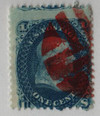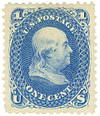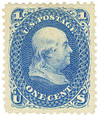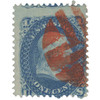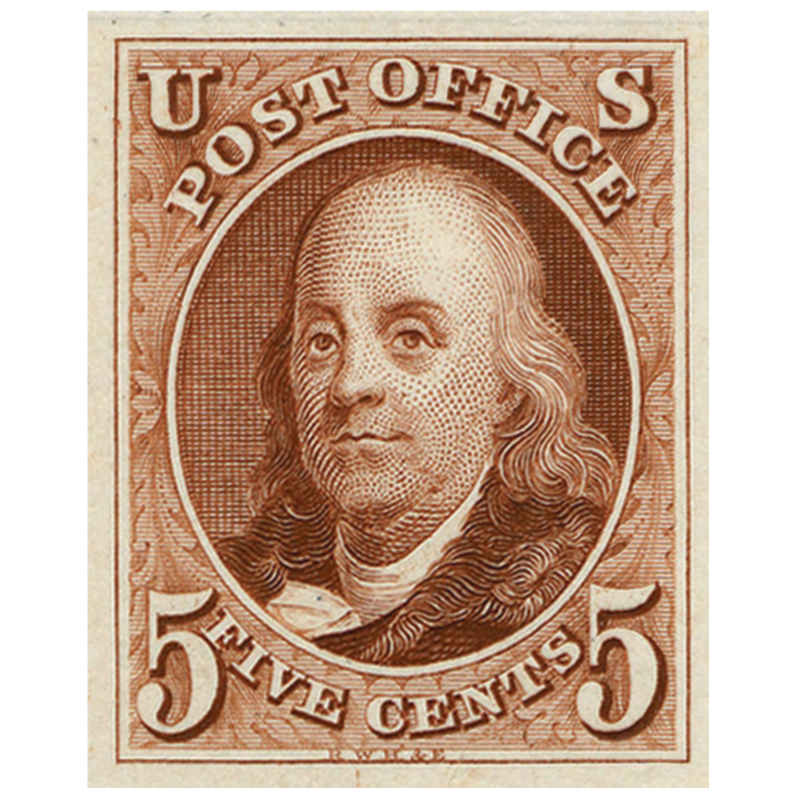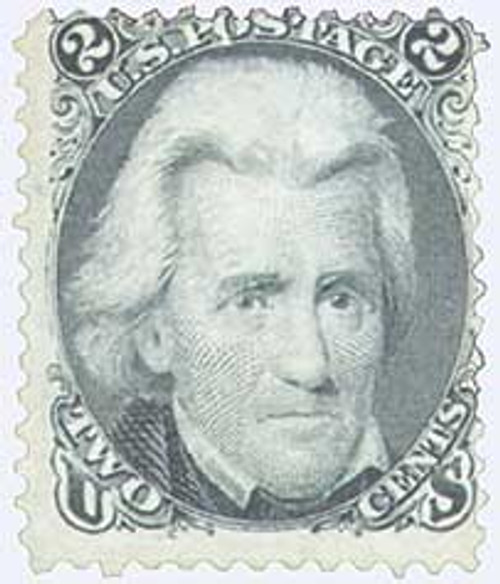
# 86 - 1867 1c Franklin, blue
Series of 1867 1¢ Franklin
“E” Grill
Quantity issued: 3,000,000 (estimate)
Method: Flat plate
Watermark: None
Perforation: 12
Color: Blue
Franklin Arrives In Philadelphia
Born and raised in Boston, Massachusetts, Franklin apprenticed in his brother’s print shop at the age of 12. During this time Franklin submitted many articles under the pseudonym “Mrs. Silence Dogood.” However, when his brother discovered that Benjamin was the author of the articles, he refused to publish them. The two brothers quarreled frequently, and at the age of 17, Franklin ran away.
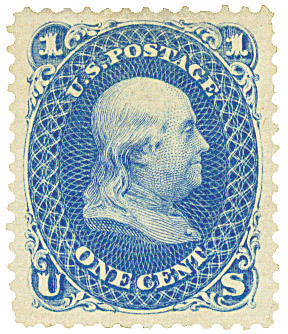
Franklin first traveled to New York City but was unable to find a job. However, while there he learned that he could work for a printer in Philadelphia.
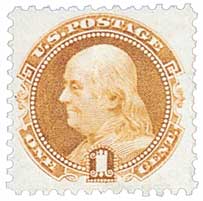
Franklin finally reached Philadelphia on October 6, 1723. As he later recalled, he was in his working clothes, with additional clothes stuffed into his pockets. Tired and hungry from the journey, he found a baker and offered all the money he had – three pence – for whatever that would get him. He received three loaves of bread, one of which he ate as he walked the streets.
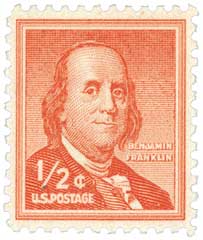
Franklin eventually followed a group of people to a Quaker meetinghouse where he slept briefly and then met a friendly Quaker who showed him a place to spend the night. There, Franklin could rest, eat, and get ready to meet the printer. However, when he met the printer, he told him that he didn’t have any work available, but offered to let him stay there. The printer also told Franklin about another printer in town who might have work for him, and this one eventually did hire him.
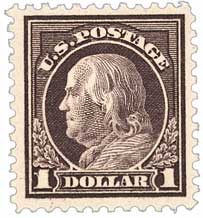
In the coming years, Franklin became a respected member of the Philadelphia community, thanks in large part to the kindness of these strangers in his early days there. Aside from his publishing work, Franklin flourished, and his accomplishments and contributions to the city earned him the title “The first citizen of Philadelphia.”
Franklin’s many contributions to the city of Philadelphia include: founding the first subscription library in the American colonies; organizing the city’s fire department; law enforcement reform; leading efforts to pave, clean, and light public streets; raising money to build a city hospital, the Pennsylvania Hospital; and founding the academy that became the University of Pennsylvania.
Click here to read Franklin’s account of his first days in Philadelphia.
Click here for more Franklin stamps.
Series of 1867 1¢ Franklin
“E” Grill
Quantity issued: 3,000,000 (estimate)
Method: Flat plate
Watermark: None
Perforation: 12
Color: Blue
Franklin Arrives In Philadelphia
Born and raised in Boston, Massachusetts, Franklin apprenticed in his brother’s print shop at the age of 12. During this time Franklin submitted many articles under the pseudonym “Mrs. Silence Dogood.” However, when his brother discovered that Benjamin was the author of the articles, he refused to publish them. The two brothers quarreled frequently, and at the age of 17, Franklin ran away.

Franklin first traveled to New York City but was unable to find a job. However, while there he learned that he could work for a printer in Philadelphia.

Franklin finally reached Philadelphia on October 6, 1723. As he later recalled, he was in his working clothes, with additional clothes stuffed into his pockets. Tired and hungry from the journey, he found a baker and offered all the money he had – three pence – for whatever that would get him. He received three loaves of bread, one of which he ate as he walked the streets.

Franklin eventually followed a group of people to a Quaker meetinghouse where he slept briefly and then met a friendly Quaker who showed him a place to spend the night. There, Franklin could rest, eat, and get ready to meet the printer. However, when he met the printer, he told him that he didn’t have any work available, but offered to let him stay there. The printer also told Franklin about another printer in town who might have work for him, and this one eventually did hire him.

In the coming years, Franklin became a respected member of the Philadelphia community, thanks in large part to the kindness of these strangers in his early days there. Aside from his publishing work, Franklin flourished, and his accomplishments and contributions to the city earned him the title “The first citizen of Philadelphia.”
Franklin’s many contributions to the city of Philadelphia include: founding the first subscription library in the American colonies; organizing the city’s fire department; law enforcement reform; leading efforts to pave, clean, and light public streets; raising money to build a city hospital, the Pennsylvania Hospital; and founding the academy that became the University of Pennsylvania.
Click here to read Franklin’s account of his first days in Philadelphia.
Click here for more Franklin stamps.



